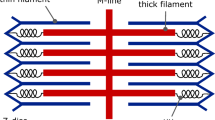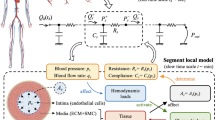Abstract
A stress-driven model for the relation between the collagen morphology and the loading conditions in arterial walls is proposed. We assume that the two families of collagen fibers in arterial walls are aligned along preferred directions, located between the directions of the two maximal principal stresses. For the determination of these directions an iterative finite element based procedure is developed. As an example the remodeling of a section of a human common carotid artery is simulated. We find that the predicted fiber morphology correlates well with experimental observations. Interesting outcomes of the model including local shear minimization and the possibility of axial compressions due to high blood pressure are revealed and discussed.
Similar content being viewed by others
References
Barocas VH, Tranquillo RT (1997) An anisotropic biphasic theory of tissue-equivalent mechanics: the interplay among cell traction, fibril alignment, and cell contact guidance. J Biomech Eng 119:137–145
Chuong CJ, Fung YC (1986) On residual stresses in arteries. J Biomech Eng 108:189–192
Cowin SC (1984) Mechanical modeling of the stress adaptation process in bone, Calcif Tissue Int 36:S98–S103
Cowin SC (2000) How is a tissue built?. J Biomech Eng 122:553–569
deBotton G (2005) Transversely isotropic sequentially laminated composites in finite elasticity. J Mech Phys Solids 53:1334–1361
deBotton G, Hariton I, Socolsky EA (2006) Neo-Hookean fiber-reinforced composites in finite elasticity. J Mech Phys Solids 54:533–559
Delfino A (1996) Analysis of stress field in a model of a human carotid bifurcation, PhD thesis, Federal Institute of Technology, Lausanne, Switzerland
Delfino A, Stergiopulos N, Moore JE, Meister JJ (1997) Residual strain effects on the stress field in a thick wall finite element model of the human carotid bifurcation. J Biomech 30:777–786
Demiray H (1972) A note on the elasticity of soft biological tissues. J Biomech 5:309–311
Driessen NJB, Peters GWM, Huyghe JM, Bouten CVC, Baaijens FPT (2003) Remodelling of continuously distributed collagen fibers in soft connective tissues. J Biomech 36:1151–1158
Driessen NJB, Wilson W, Bouten CVC, Baaijens FPT (2004) A computational model for collagen fiber remodelling in the arterial wall. J Theo Biol 226:53–64
Driessen NJB, Bouten CVC, Baaijens FPT (2005) A structural constitutive model for collagenous cardiovascular tissue incorporating the angular fiber distribution. J Biomech Eng 127:494–503
Eberlein R, Holzapfel GA, Schulze-Bauer CAJ (2001) An anisotropic model for annulus tissue and enhanced finite element analyses of intact lumbar disc bodies. Comput Meth. Biomech Biomed Eng 4:209–230
Finlay HM, Whittaker P, Canham PB (1998) Collagen organization in the branching region of human brain arteries. Stroke 29:1595–1601
Fridez P, Makino A, Miyazaki H, Meister JJ, Stergiopulos N (2001) Short-term biomechanical adaptation of the rat carotid to acute hypertention: contribution of smooth muscle. Ann Biomed Eng 29:26–34
Gasser TC, Holzapfel GA (2002) A rate-independent elastoplastic constitutive model for biological fiber-reinforced composites at finite strains: continuum basis, algorithmic formulation and finite element implementation. Comp Mech 29: 340–360
Gasser TC, Ogden RW, Holzapfel GA (2005) Hyperelastic modelling of arterial layers with distributed collagen fibre orientations. J R Soc Interface DOI: 10.1098/rsif.2005.0073
Hariton I, deBotton G, Gasser TC, Holzapfel GA (2005) How to incorporate collagen fiber orientations in an arterial bifurcation. In Hamza: MH (ed.) Proceedings of the 3rd IASTED International conference on biomechanics, Benidorm, Spain, 2005. ACTA Press, Anaheim, pp 101–104
Holzapfel GA (2000) Nonlinear solid mechanics. A continuum approach for engineering. Wiley, Chichester
Holzapfel GA, Gasser TC, Ogden RW (2000a) A new constitutive framework for arterial wall mechanics and a comparative study of material models. J Elast 61:1–48
Holzapfel GA, Schulze-Bauer CAJ, Stadler M (2000b) Mechanics of angioplasty: wall, balloon and stent. In: Casey J, Bao G (eds) Mechanics in biology The American Society of Mechanical Engineers (ASME), AMD-vol 242/BED-vol 46. Springer, Berlin Heidelberg New York, pp 141– 156
Holzapfel GA, Gasser TC, Stadler M (2002a) A structural model for the viscoelastic behavior of arterial walls: continuum formulation and finite element simulation. Eur J Mech A/Solids 21:441–463
Holzapfel GA, Stadler M, Schulze-Bauer CAJ (2002b) A layer-specific 3d model for the simulation of balloon angioplasty using MR imaging and mechanical testing. Ann Biomed Eng 30:753–767
Holzapfel GA, Gasser TC, Ogden RW (2004) Comparison of multi-layer structural model for arterial walls with a Fung-type model, and issues of material stability. J Biomech Eng 126:264–275
Holzapfel GA, Sommer G, Gasser TC, Regitnig P (2005) Determination of the layer-specific mechanical properties of human coronary arteries with non-atherosclerotic intimal thickening, and related constitutive modelling. Am J Physiol Heart Circ Physiol, PMID: 16006541
Huiskes R, Ruimerman R, van Lenthe GH , Janssen JD (2000) Effects of mechanical forces on maintenance and adaptation of form in trabecular bone. Nature 405:704–706
Humphrey JD (1999) Remodeling of collagenous tissue at fixed lengths. J Biomech Eng 121:591–597
Humphrey JD. (2002) Cardiovascular solid mechanics – Cells, tissues and organs. Springer, Berlin Heidelberg New York
Humphrey JD, Na S (2002) Elastodynamics of arterial wall stress. Ann Biomed Eng 30:509–523
Konta T, Bett JHN (2003) Patterns of coronary artery movement and the development of coronary atherosclerosis. Circ J 67:846–850
Kuhl E, Garikipati K, Arruda EM, Grosh K (2005) Remodeling of biological tissue: mechanically induced reorientation of a transversly isotropic chain network. J Mech Phys Solids 53:1552–1573
Lopez-Pamies O, Ponte Castañeda P (2004) Second-order homogenization estimates incorporating field fluctuations in finite elasticity. Math Mech Solids 9:243–270
Matsumoto T, Hayashi K (1994) Mechanical and dimensional adaptation of rat aorta to hypertension. J Biomech Eng 116:278–283
Menzel A (2005) Modelling of anisotropic growth in biological tissues. Biomech Model Mechanobiol 3:147–171
Nerem RM, Seliktar D (2001) Vascular tissue engineering. Annu Rev Biomed Eng 3:225–243
Ogden RW (1974) On the overall moduli of non-linear elastic composite. J Mech Phys Solids 22:541–553
Oktay HS, Kang T, Humphrey JD, Bishop GG (1991) Changes in the mechanical behavior of arteries following bal1 loon angioplasty. In: ASME 1991 biomechanics symposium, vol 120, ASME
Ponte Castañeda P, Tiberio E (2000) A second-order homogenization method in finite elasticity and applications to black-filled elastomers. J Mech Phys Solids 48:1389–1411
Rachev A (2003) Remodeling of arteries in response to changes in their mechanical environment. In: Holzapfel GA, Ogden RW. (eds) CISM course and lectures – Biomechanics of soft tissue in cardiovascular systems, vol 441. Springer, Berlin Heidelberg New York, pp 100–161
Rachev A, Manoach E, Moore JE Jr (2000) A model of stress-induced geometrical remodeling of vessel segments adjacent to stents and artery/graft anastomoses. J Theo Biol 206:429–443
Rachev A, Stergiopulos N, Meister JJ (1996) Theoretical study of dynamics of arterial wall remodeling in response to changes in blood pressure. J Biomech 5:635–642
Rhodin JAG (1980) Architecture of the vessel wall. In: Sparks HV, Bohr DF, Somlyo AD, Geiger SR (eds) Handbook of physiology, the cardiovascular system, vol 2, American Physiological Society, Bethesda, Maryland, pp 1–31
Schulze-Bauer CAJ, Mörth C, Holzapfel GA (2003) Passive biaxial mechanical response of aged human iliac arteries. J Biomech Eng 125:395–406
Seliktar D, Nerem RM, Galis ZS (2003) Mechanical strain-stimulated remodeling of tissue-engineering blood vessel constructs. Tissue Eng 9:657–666
Steinman DA, Vorp DA, Ethier CR (2003) Computational modeling of arterial biomechanics: insights into pathogenesis and treatment of vascular disease. J Vasc Surg 37:1118–1128
Taber LA (1995) Biomechanics of growth, remodeling and morphogenesis. Appl Mech Rev 48:487–545
Taber LA, Eggers DW (1996) Theoretical study of stress-modulated growth in the aorta. J Theo Biol 180:343–357
Taber LA, Humphrey JD (2001) Stress-modulated growth, residual stress, and vascular heterogeneity. J Biomech Eng 123:528–535
Taylor RL (2002) FEAP – a finite element analysis program, version 7.4 user manual. University of California at Berkeley, Berkeley California
Thubrikar MJ, Robicsek F (1995) Pressure-induced arterial wall stress and atherosclerosis. Ann Theor Surg 59:1594–1603
Tozzi P, Hayoz D, Oedman C, Mallabiabarrena I, Von Segesser LK (2001) Systolic axial artery length reduction: an overlooked phenomenon in vivo. Am J Physiol 280:H2300–H2305
Vaishnav RN, Vossoughi J (1983) Estimation of residual strains in aortic segments. In: Hall CW. (ed) Biomedical engineering II: recent developments. Pergamon Press, New York, pp 330–333
Weiss JA, Maker BN, Govindjee S (1996) Finite element implementation of incompressible, transversly isotropic hyperelasticity. Comput Methods Appl Mech Eng 135:107–128
Zulliger MA, Friedez P, Hayashi K, Stergiopulos N (2004) A strain energy function for arteries accounting for wall composition and structure. J Biomech 37:989–1000
Author information
Authors and Affiliations
Corresponding author
Additional information
In memory of Zinaida Hariton, 1926–2002
Rights and permissions
About this article
Cite this article
Hariton, I., deBotton, G., Gasser, T.C. et al. Stress-driven collagen fiber remodeling in arterial walls. Biomech Model Mechanobiol 6, 163–175 (2007). https://doi.org/10.1007/s10237-006-0049-7
Received:
Accepted:
Published:
Issue Date:
DOI: https://doi.org/10.1007/s10237-006-0049-7




